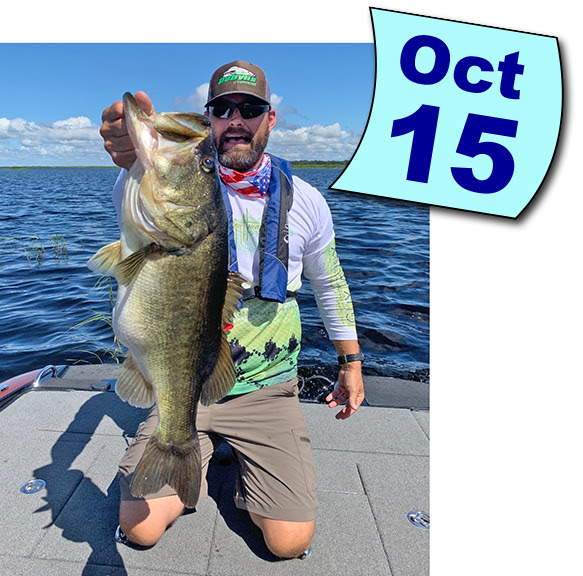
TrophyCatch Season 7 ended on September 30, and anglers have through October 15 to get their qualifying catches submitted! As of mid-September the current totals were:
- 802 Lunker Club (8 - 9.9 lbs.) bass
- 239 Trophy Club (10 - 12.9 lbs.) bass
- 11 Hall of Fame (13+ lbs.) bass
for a combined total of 1,052 trophy bass caught-and-released in Season 7 so far! A program total of over 9,000 bass have been successfully caught, documented, and released for prizes from TrophyCatch since 2012.
|
Here's where our current Season 7 catch submissions are coming from around the state.
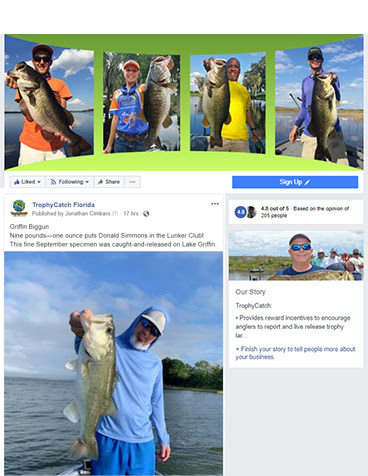 | |
Stay up to date on TrophyCatch, partner promotions, special events, and our top producing anglers by liking our TrophyCatch Facebook page and subscribing to the TrophyCatch YouTube Channel. Who knows — you might see us bragging about you and your trophy photo here soon! |
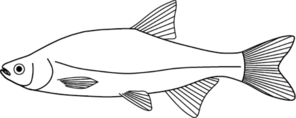
Size: This popular minnow can grow to a foot in length. Neither the FWC nor IGFA maintains records on this species, as it is sought after primarily as bait and not for sport.
Identification and similar species: The golden shiner is a deep-bodied and extremely compressed (flat) fish; also note the down-curved lateral line. A scaleless keel (ridge) is present on the bottom of the belly. The golden color for which the fish is named can be helpful in identification, but is not always present.
Tiny tarpon or small grass carp might possibly be mistaken for the shiner, but the down-curved lateral line and keel set the shiner apart. Threadfin and gizzard shad possess a distinct black spot near the operculum that is absent in the shiner, and also lack the keel.
|
Angling qualities: This fish is the best all-around live bait for both largemouth bass and butterfly peacock bass. Shiners can be taken legally with a cast net (see the Florida Freshwater Fishing Regulations for details, and be sure to immediately release any sportfish taken in this manner). Experienced cast-netters will often chum an area with uncooked oatmeal, laying mash, bread, or similar baits to attract and concentrate schools of these fish before throwing the net. For more tips on netting your own see the Bait Net Basics article below. Shiners can also be easily caught on hook-and-line with a tiny (size 12 or smaller) Aberdeen hook baited with a small doughball and fished under a tiny bobber.
Shiners, although not nearly as delicate as live shad, should still be kept in an aerated livewell or in a ventilated bait bucket placed in the water. This bait is usually hooked below the dorsal fin or through the lips. Use a float that is just large enough to keep the shiner from pulling it under; small balloons are also popular as shiner bobbers because they do not hang up in surface vegetation as easily as hard plastic or foam bobbers. Alternatively, shiners can be freelined around promising looking cover with no bobber or weight at all for a more natural presentation.
Where to find them: Golden shiners are common to abundant throughout the state. They are usually found near vegetation.
Interesting facts: When spawning golden shiners release adhesive eggs that stick to nearby vegetation. Their chief food includes freshwater plankton and insect larvae.
FWC illustration
 | |
Did you know? The Big Catch angler recognition program helps you celebrate memorable-sized catches of 33 freshwater species! A qualifying submission nets you a personalized certificated suitable for framing and hanging.
|
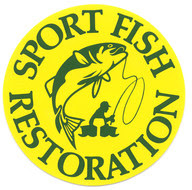
How often do you see people or businesses wanting to be taxed and happy about it? You may not realize how much it has benefited you, but the Federal Aid in Sportfish Restoration (SFR) program has proven for more than half a century to be one of the best “user-pays, user-benefits” initiatives anywhere.
In 1937, President Franklin D. Roosevelt signed the Federal Aid in Wildlife Restoration Act. Between 1941 and 1950, sport-fishing businesses paid a federal excise tax that was deposited in the general treasury of the United States but did not directly benefit manufacturers or anglers. In 1950, sportsmen and businesses teamed with conservation-minded policy makers to redirect these existing federal excise taxes to the Restoration Program.
The concept was to restore sportfish populations and improve public access, so more people can enjoy fishing and so fishing sales would increase. Sport Fish Restoration (SFR) came about as a result of anglers wanting to see more money directed toward restoring the nation’s recreational fisheries, and ensuring better fishing opportunities for themselves and future generations.
|

Federal excise taxes collected on the sale of fishing reels and other fishing tackle, as well as a motor boat fuel tax, provide a remarkable annual return on investment for manufacturers of outdoor equipment. These excise taxes are paid up front by the outdoor recreation industry (such as fishing tackle and boating manufacturers). Although these costs are of course passed on to anglers, the share paid by the individual consumer is very small. However, the accumulated return to outdoors enthusiasts and the outdoors industry as a group are dramatic. For example, one study determined that for excise taxes paid on fishing equipment like rods, reels, and lures, the return on investment was an average of 2,100 percent over 51 years (1955-2006). In plain English, for every $1 paid by the sporting goods industry in federal excise taxes that support fishing programs, those industries made $21 back in fishing equipment sales.
|

In Florida, SFR provides millions of dollars to support boating access and freshwater fisheries conservation, which helps to support fisheries that provide $1.7 billion in economic benefit to the State — as well as providing 46 million days of outdoor recreation enjoyment annually! The FWC uses this money to improve fisheries habitat, stock fish, conduct research and manage fish populations. FWC also conducts aquatic education programs and provides valuable fishing and conservation information to anglers. The next time you go fishing, remember SFR — three important letters that make fishing better!
|
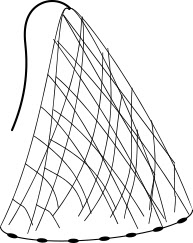
Nets provide a great way to collect bait like the golden shiner featured above. With a small investment and some knowledge you can catch your own bait — which can provide its own brand of fun!
Cast net - A cast net is probably the most widely used net in Florida. It has the advantages of a long reach and wide coverage. However, a cast net is also the hardest net to learn to use, although many bait and tackle shops will provide demonstrations and there are also plenty of videos and books that cover the subject.
Cast nets are ideal for taking shiners and shad. Shiners can be baited to a particular area with bread, uncooked oatmeal, or chicken laying mash (check your local feed store for the latter). A good place to start up a “shiner hole” needs to have some open water with vegetation close by. If you’re willing to put in some extra effort and cash, you can chum shiners to a particular area at least weekly (twice a week or more is better) and have a semi-guaranteed supply of bait whenever you want it. In such a situation, you can chum your “shiner hole” and start tossing your cast net within five or ten minutes to collect your bait. If chumming “cold” (you haven’t been baiting the area previously), you may need to chum for fifteen to twenty minutes before throwing your net. In either case, make your first cast count because the sound of the net hitting the water will scare the baitfish and, while you can still catch them, your chances on subsequent throws won’t be as good. For keeping your shiners alive, an aerated livewell or cooler is best. However, anglers can also make do with a plastic five-gallon bucket with half-inch holes drilled in it for circulation; throw on a bait lid available at any tackle shop and keep the bucket in the water on a rope until you need your next bait.
|

Shad are a different story — their occurrence in most waters is much less predictable. They are schooling fish constantly on the move, and are usually found in open water instead of orienting reliably to vegetation. This also means that they’re often found farther from shore than shiners are, sometimes putting them out of reach unless you’re throwing your net from a boat. Your best bet for a steady supply of shad is to keep a sharp eye out for schools on the surface or crashing bass. Shad are also much more delicate than shiners — you’ll need a well-aerated baitwell to keep them alive, the bigger the better. Shad schools are usually denser than shiner schools, though, and one lucky cast is all you need to fill a baitwell.
|
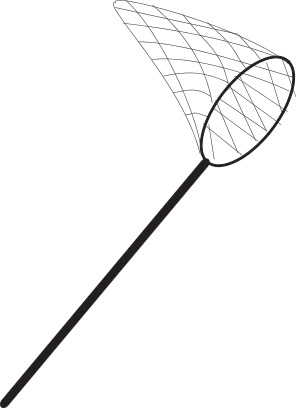
Dip net - Dip nets are simpler in every respect, as well as cheaper. You’ll seldom catch a shiner or shad in one, but if you want some grass shrimp or minnows for bream fishing this is all you’ll need. If you’re using a dip net you’ll be restricted to shore, but then that’s where you’ll want to be using this net anyway. Try scooping the net through shoreline vegetation, and pass the net through the same path several times. Good vegetation to “beat” includes any grass, shallow hydrilla, or peppergrass. After “sweeping” a couple of spots, stop and pick through the vegetation in the net for bait. (Note that most emergent vegetation worked this way will spring back up in a few hours, but be careful not to damage any desirable plant species.) Grass shrimp usually announce themselves by jumping all over the place inside the net bag, and are a great bait for bream and the occasional bass. Minnows aren’t quite as fantastic a bait for bream, but are still good and large bluegill in particular have a preference for mosquitofish. Better dip nets have a sturdy wooden handle about six feet long and a heavy-duty wire net frame with a 1/4” mesh bag. Don’t go any bigger on the mesh size, or most of what you want to catch will be able to get through it.
|
Minnow seine - Minnow seines are not as effective or convenient for shiners as a cast net, and are more cumbersome for shrimp or minnows than a dip net. You also can’t work one solo — it takes two for this one. They do have the advantage of being capable of covering a lot of territory, however. And seines make great educational tools, if you want to see (or teach your kids about) the variety of life in your local pond. If you’re going to use a minnow seine, do yourself the favor of attaching five- or six-foot broom handles or one-by-twos at the ends. This will make the net much easier to work, and make it much easier to keep the lead line on the bottom. They also make the net easy to roll up for storage — but make sure it's completely dry first. To work the net properly, choose a path that will run the net through promising-looking water a few feet deep and then up onto the bank. A gently-sloping bank without much vegetation or brush on it is best if available. Both team members should grasp the broom handles upright and try to keep the lead line on the bottom as they work. There will be a deep bow in the net as you both walk forward in unison. Move as fast as you can to prevent fish from escaping, and do keep that lead line on the bottom or fish will also escape under the net. Run the seine right up onto the bank to inspect your catch, giving priority to releasing any game fish first.
Staying safe - Obviously, you should exercise the same caution when netting as you would when shoreline fishing or wading, watching for deep spots and wildlife. See FWC's Living with Alligators brochure for more information.
"Netiquette" - There are some final points every net-toting angler should consider that have nothing to do with catching fish. First, don’t trespass. Respect the space around other resource users nearby. Also, don’t leave a trail of weed piles along the shoreline behind you. Some people, including anglers, don’t like seeing people with nets, so be polite to anyone that asks you what you’re doing. Take a moment to explain how much fun it can be to catch your own bait, and maybe even show them some of the interesting creatures you come across doing it.
Freshwater Fishing and Net Regulations - Methods of taking bait: Freshwater shrimp and golden shiners of any size, or other freshwater nongame fish, including catfish, less than 8-inches total length may be taken for bait by the following methods, unless specifically prohibited:
■ Cast nets having a stretched mesh size not greater than 1 inch in fresh waters of the
state, unless specifically prohibited.
■ Minnow dip nets not more than 4 feet in diameter.
■ Minnow seines having a stretched mesh size not greater than 1 inch, a length not more than
20 feet, and a depth not more than 4 feet.
■ Any game fish taken by these methods must be released immediately.

Description: Bobby Hicks Park is a pond in the FWC’s Urban Fishery Project, a group of designated Fish Management Areas in an urban setting that are intensively managed for exceptional fishing opportunities. There are 11 urban fisheries in the FWC’s Southwest Region, located primarily in the St. Petersburg and Tampa area. Special amenities at these sites includes fish feeders, aeration systems, regular stocking of sportfish, fishing piers, free youth fishing events, and improved aquatic habitat and water quality — all in a family-friendly environment.
Bobby Hicks is a borrow pit that was dug to build military housing. In 1999 the City of Tampa planted 200 cypress trees and 50 sabal palms to replace undesirable exotic shoreline vegetation. In 2002 the Tampa chapter of the Safari Club International donated materials and labor to construct a 170-foot fishing pier at the park.
|

Soon after the opening of the fishing pier, the City of Tampa implemented the use of a mechanical harvester to manage a growing hyacinth and water lettuce inundation. Managers quickly found that the harvester could not compete with the grow rates of these floating plants. As soon as the harvester completed one section of the pond, the hyacinth and water lettuce would have completely overtaken the other recently-harvested areas. The coverage made it impossible to fish and deprived many sportfish from oxygen, destroying the thriving sportfish population.
|

The FWC’s Division of Freshwater Fisheries Management (DFFM) biologists recommended herbicide treatment to reestablish some open water and maintain access to the fishery. The first electrofishing sampling following the treatment yielded only rough fish like gar, bowfin and tilapia. DFFM then initiated fish stocking in order to bring largemouth bass, redear sunfish, channel catfish and bluegill back into the resource. Today, the stocking has resulted in a trophy channel catfish fishery and extremely good largemouth bass fishing. A connection to Tampa Bay regularly leads to large common snook being caught at Bobby Hicks and several large tarpon have regularly been seen cruising the pier or chasing bait.
|
The Bobby Hicks Park fishing pier and a number of other enhancements provide a variety of outstanding fishing opportunities for the whole family.
Bobby Hicks has a hard sand and clay bottom with plenty of depth that, thanks to ongoing management work, offers great angling opportunities all year long. Largemouth bass anglers have good luck dragging Texas-rigged stick worms or casting crankbaits around drop-offs and humps in deep water. The fishing pier at Bobby Hicks presents excellent opportunities for trophy-sized channel catfish due to the feeders positioned on the pier. Each day the feeders distribute fish feed at 9:00 a.m., 12:00 p.m., and 6:00 p.m. Channel catfish at Bobby Hicks can be caught on chicken livers, night crawlers, stink baits and live bluegill fished on the bottom. Live bait is best presented for catfish on a slip sinker rig, and non-live bait is best presented on a 3-way swivel rig to suspend the bait just off the bottom. Bream species such as redear sunfish and bluegill can be taken on small minnows or red worms, concentrating effort around brush and cattails in shallow water. Snook are caught casting artificial lures such as fluke-style baits and small paddle tail swimbaits around the brush-covered shorelines on the north end of the pond. Kayaking anglers enjoy the opportunities to catch phenomenal fish at Bobby Hicks; although there is not a formal launch site the pond provides ample areas for hand launching. To find a pond near you visit our list of Fish Management Areas!
To contact the Florida Freshwater Angler, email John Cimbaro. |

















No comments:
Post a Comment